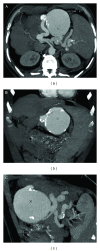Transcatheter embolization for giant splenic artery aneurisms: still an open question
- PMID: 22900219
- PMCID: PMC3414005
- DOI: 10.1155/2012/652469
Transcatheter embolization for giant splenic artery aneurisms: still an open question
Abstract
Transcatheter embolization is the mainstay of the therapy of splenic artery aneurysms (SAAs) in patients with portal hypertension. It is indicated when the SAA diameter reaches 20 mm. Although endovascular techniques are effective and safe for the treatment of medium-sized SAAs, little is known about their applicability to large-sized SAAs. Herein, we report a case of giant SAA, which was treated with transcatheter coil embolization. The case was not considered suitable for surgery because of the presence of severe portal hypertension. The procedure was complicated by bacterial infection of the coils within the aneurismatic sac, leading to the development of hepatic failure. A liver transplant was then successfully performed despite the presence of a nonresponsive infection.
Figures




References
-
- Madoff DC, Denys A, Wallace MJ, et al. Splenic arterial interventions: anatomy, indications, technical considerations, and potential complications. Radiographics. 2005;25:S191–S211. - PubMed
-
- Kóbori L, van der Kolk MJ, de Jong KP, et al. Splenic artery aneurysms in liver transplant patients. Journal of Hepatology. 1997;27(5):890–893. - PubMed
-
- Yamamoto S, Hirota S, Maeda H, et al. Transcatheter coil embolization of splenic artery aneurysm. CardioVascular and Interventional Radiology. 2008;31(3):527–534. - PubMed
-
- Berceli SA. Hepatic and splenic artery aneurysms. Seminars in Vascular Surgery. 2005;18(4):196–201. - PubMed
LinkOut - more resources
Full Text Sources

